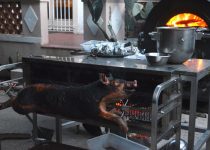Turning Up the Heat: Is Outdoor Steaming the Secret to Perfect Pastrami?
I've tried a lot of techniques for making pastrami, but outdoor steaming really stands out. Starting with good quality beef brisket, smoking it till it's just right, and then moving to the steaming stage outdoors seems to add an extra something to the flavor. By steaming over a consistent heat source on a grill or campfire, the meat becomes incredibly tender and juicy, infused with a unique smoky essence. Adding a touch of beef broth or red wine during steaming can elevate the taste even further. It's a fun, engaging process and, trust me, getting that perfect slice of pastrami might just surprise you.
Table of Contents
Key Takeaways
- Outdoor steaming maintains consistent heat, crucial for the tender, juicy texture of perfect pastrami.
- The unique smoky touch from outdoor cooking enhances the pastrami's flavor profile.
- Steaming outdoors allows for cooking multiple briskets simultaneously, ideal for large gatherings.
- Utilizing natural elements like wood from a campfire can infuse additional aromas not achievable indoors.
- The process engages culinary enthusiasts, offering an authentic and interactive cooking experience.
The Basics of Pastrami Making
Making pastrami starts with smoking the meat until it reaches an internal temperature of 150-160 degrees. When I'm aiming for that perfect slice of homemade pastrami, I always choose a good quality beef brisket. The choice of meat is important because it's the foundation of the flavor and tenderness you're going for.
Now, smoking isn't just about cooking the meat; it's an art that infuses the brisket with complex flavors. It requires patience and precision. You have to maintain a consistent temperature and keep those wood chips smoking to envelop the brisket in that rich, smoky aroma. It's this step where the brisket starts to transform, the edges caramelizing slightly, the surface forming that desirable crust.
After smoking, the next essential step is steaming. This technique isn't about rushing; it's about gently bringing the meat to its final stage of perfection. Steaming the brisket ensures it becomes tender without becoming mushy. Steaming also helps in retaining the essence of the spices and smoke, enhancing the overall flavor profile. When done right, the internal temperature should ideally read between 170-190 degrees, leaving you with pastrami that's just irresistible.
Outdoor Steaming Techniques
While outdoor steaming adds a unique smoky flavor, it requires specific techniques to guarantee the pastrami turns out tender and delicious. When I'm prepping my homemade pastrami, the choice of beef brisket is important. Selecting a cut with the right amount of fat ensures it won't dry out during the steaming process.
For outdoor steaming, I set up a large pot or steamer over my grill or campfire. It's important to maintain a steady heat source; too hot, and the brisket can toughen, too low, and you won't get that rich, smoky infusion. I use a steaming basket to keep the brisket elevated, ensuring an even cook. This setup not only locks in moisture but also allows those smoky flavors from the campfire to permeate the meat, enhancing its flavor profile.
I typically let the brisket steam for several hours. It's a slow process, but patience is key here. The result is a beautifully tender, juicy piece of pastrami that's infused with a distinct outdoor essence. This method turns the ordinary steaming process into a flavorful adventure, making the most of both the technique and the outdoor cooking experience.
Benefits of Outdoor Cooking
Outdoor cooking not only enhances the flavor of pastrami with a unique smoky touch, but it also offers several practical benefits. When I'm steaming outdoors, I've noticed a significant improvement in how the brisket point absorbs those irresistible smoky flavors, providing a taste that's hard to replicate indoors. The process itself transforms into an engaging cooking experience, one that truly captivates anyone who loves the art of food preparation.
- Consistent Heat Levels: Managing the fire or heat source outdoors allows me to maintain a steady temperature, which is vital for the even cooking of multiple pastramis.
- Authentic Cooking Experience: There's something about being outdoors, with the fire crackling and the aroma of steamed pastrami in the air, that enriches the entire culinary process.
- Capacity for Larger Batches: Outdoor setups often provide the space to steam several pastramis simultaneously, making it ideal for gatherings or commercial purposes.
Perfecting the Flavor Profile
I often enhance the flavor profile of my pastrami by adding a mix of beef broth and red wine to the steaming process. This combination not only deepens the savory notes but also introduces a subtle complexity that elevates the meat's taste. By utilizing a pressure cooker, I can guarantee that these flavors are deeply infused into the pastrami, making every bite as flavorful as possible.
Experimenting with different liquids and ingredients during the steaming process has been a game changer for me. It's not just about moisture; it's about creating a signature flavor that can't be replicated. I always make sure to place the meat on a trivet inside the pressure cooker. This technique prevents the pastrami from becoming soggy and allows for an even distribution of the flavorful steam.
Moreover, the right mix of beef broth and red wine can make all the difference. It's not just pouring these in and hoping for the best; it's about balancing the flavors to complement the natural taste of the pastrami. Each batch is an opportunity to tweak and refine, making the steaming process as much an art as it's a science.
Serving and Pairing Ideas
After perfecting the pastrami's flavor, let's explore some classic and creative ways to serve and pair this delicious meat. Originating from the corned beef tradition, pastrami has become a staple in New York delis, renowned for its ability to slices cleanly and melts in your mouth.
Here's how to serve it up right:
- The Classic New Yorker: Pile high thin slices of steaming pastrami on rye bread, slathered with mustard and topped with crunchy pickles. This sandwich is a tribute to simplicity and flavor, capturing the essence of New York street food.
- The Gourmet Reuben: Transform your pastrami into a luxurious Reuben sandwich. Layer it with Swiss cheese, sauerkraut, and generous smears of Russian dressing on rye. Toast it until the cheese bubbles and the edges crisp up, creating a rich blend of flavors and textures.
- The Modern Platter: Serve sliced pastrami with a side of potato salad, assorted pickled vegetables, and a cold beer. This pairing balances the rich, savory flavors of the meat with the tanginess of the pickles and the creaminess of the potato salad.
Whether you're a seasoned chef or a curious foodie, these ideas guarantee a mouthwatering pastrami experience every time.
Frequently Asked Questions
What Temperature Do You Steam Pastrami At?
I steam pastrami at about 150 degrees Fahrenheit, ensuring temperature consistency for moisture control. My steamer type and equipment setup focus on even cooking and flavor impact over the cooking duration. Safety's key!
Why Do You Steam Pastrami?
I steam pastrami to retain moisture, enhance flavor, and soften texture. It tenderizes the meat, completes cooking, and honors traditional methods. This technique also highlights its cultural significance and optimizes it for serving.
What Is the Best Way to Heat up Pastrami?
I've found steaming pastrami retains moisture best, enhancing flavor. I slice it before heating, usually avoiding the microwave for health reasons. Oven methods are fine, but nothing beats steaming for perfect sandwiches.
What Is the Best Wood to Smoke Pastrami With?
I've found that the best wood to smoke pastrami with depends on desired flavor profiles, from sweet apple to robust hickory, considering moisture content, chip size, and sustainable sourcing to enhance aroma and taste.




